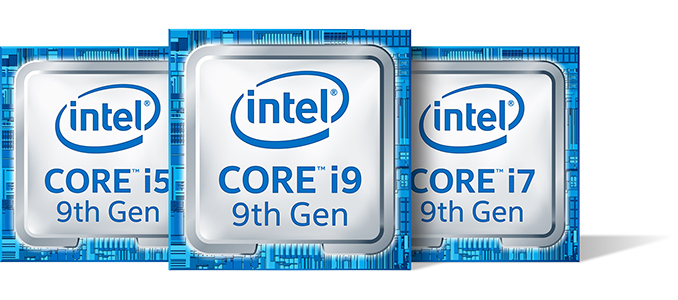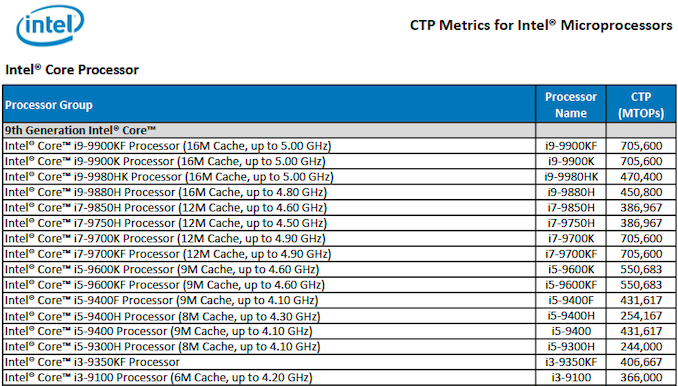Intel Details New 9th Gen CPUs for Notebooks: i9-9980HK to i5-9300H
by Anton Shilov on February 16, 2019 11:00 AM EST- Posted in
- CPUs
- Intel
- Coffee Lake
- Core 9th Gen
- i9-9980HK

Intel is yet has to announce its 9th Gen Core processors for laptops officially, but because the company needs to sort out all the things with authorities and regulators well in advance of actual product launches, CPU model numbers and general specifications have been published well ahead of the formal release. As it turns out, recently the company disclosed the first details about its 9th Gen mobile Core i9, Core i7, and Core i5 H-series processors for higher-end laptops.
Before proceeding to the actual products, let us make it clear what Intel actually revealed. Among other things, Intel (and other companies) has a number of export compliance metrics for its CPUs, including GFLOPS, Adjusted Peak Performance (APP), and Composite Theoretical Performance (CTP). These metrics are used by various governments to determine capabilities of CPUs and other processors. The APP and GFLOPS metrics are used by the US Department of Commerce’s Bureau of Industry and Security (BIS). Meanwhile, other authorities and regulators use CTP calculations, which are stated in Millions of Theoretical Operations Per Second (MTOPS), to assess what companies import to their countries. The CTP numbers are the ones that Intel published for its yet-to-be released CPUs.
The mobile CPUs newly listed are the eight-core Core i9-9980HK processor with unlocked multiplier, the eight-core Core i9-9880H, the eight-core Core i7-9850H, the eight-core Core i7-9750H, the quad-core Core i5-9400H, and the quad-core Core i5-9300H. All of them are aimed at high-performance laptops for gamers and professionals and, according to Intel, will be launched in the second quarter. Since the new processors belong to Intel’s 9th Gen Core family are designed to feature hardware mitigations against specific Meltdown and Spectre vulnerabilities. Meanwhile, a quick look at the basic specs that Intel published as well as their CTP numbers can shed some light on general specifications of the upcoming 9th Gen Core H-series mobile processors.
| Intel 9th Gen Core CPUs for Desktops and High-End Notebooks | |||||||||
| Tier | Model | Application | Cores | Base Freq |
Turbo Freq |
L3 | IGP | IGP Freq |
TDP |
| i9 | i9-9900K | Desktop | 8 / 16 | 3.6 GHz | 5.0 GHz | 16 MB | UHD 630 | 1200 | 95 W |
| i9-9900KF | Desktop | 8 / 16 | 3.6 GHz | - | - | 95 W | |||
| i9-9980HK | Notebook | 8 / 16 | ? | UHD 630 (?) | ? | ? | |||
| i9-9880H | Notebook | 8 / 16 | ? | 4.8 GHz | ? | ? | |||
| i7 | i7-9700K | Desktop | 8 / 8 | 3.6 GHz | 4.9 GHz | 12 MB | UHD 630 | 1200 | 95 W |
| i7-9700KF | Desktop | 8 / 8 | 3.6 GHz | 4.9 GHz | - | - | 95 W | ||
| i7-9850H | Notebook | 8 / 8 | ? | 4.6 GHz | UHD 630 (?) | ? | ? | ||
| i7-9750H | Notebook | 8 / 8 | ? | 4.5 GHz | ? | ? | |||
| i5 | i5-9600K | Desktop | 6 / 6 | 3.7 GHz | 4.6 GHz | 9 MB | UHD 630 | 1150 | 95 W |
| i5-9600KF | Desktop | 6 / 6 | 3.7 GHz | 4.6 GHz | - | - | 95 W | ||
| i5-9400 | Desktop | 6 / 6 | 2.9 GHz | 4.1 GHz | UHD 630 | 1050 | 65 W | ||
| i5-9400F | Desktop | 6 / 6 | 2.9 GHz | 4.1 GHz | - | - | 65 W | ||
| i5-9400H | Notebook | 4 / 8 | ? | 4.3 GHz | 8 MB | UHD 630 (?) | ? | ? | |
| i5-9300H | Notebook | ? | 4.1 GHz | ? | ? | ||||
| i3 | i3-9350KF | Desktop | 4 / 4 | 4.0 GHz | 4.6 GHz | - | - | 91 W | |
| i3-9100 | Desktop | ? | ? | 4.2 GHz | 6 MB | UHD 630 (?) | ? | ? | |
NOTE 1: Keep in mind that Intel has only published very basic specificationsof its upcoming 9th Gen Core CPUs for notebooks (i.e., Turbo frequency and cache size), which is why a number of details published here (e.g., core count, iGPU) are not confirmed officially at this point.
Obviously, the Core i9-9980HK and the Core i9-9980H will sit on top of the range offering eight cores with Hyper-Threading, 16 MB of L3 cache as well as Turbo frequencies close to their desktop counterparts. Meanwhile, the difference between CTP of desktop Core i9 and notebook Core i9 CPUs clearly indicates that their base clocks will be considerably lower, possibly to maintain a 45 W TDP.
Intel’s Core i7-9850H and the Core i7-9750H processors will sit below their Core i9-branded brethren. These chips will feature eight cores (without HT) capable of running at up to 4.6 GHz along with 12 MB of L3 cache. Just like in case of higher-end parts, these CPUs will be clocked considerably lower than their desktop colleagues.
Surprisingly, as far as the cache size and CTP numbers are concerned, the 9th Gen Core i5 H-series processors will not feature six cores, but will pack four Hyper-Threaded cores with 8 MB of L3. While the Core i5-9300H chip will probably run faster than the Core i5-8300H, the Core i5-9400H will have exactly the same base frequency as the Core i5-8400H as they have the same CTP of 254,167 MTOPS.
In addition to mobile CPUs, Intel also disclosed some preliminary details about its entry-level quad-core Core i3-9100 CPU in its document. The chip will run at frequencies of up to 4.2 GHz and will feature 6 MB of L3 cache. Since this is a lower-end part, expect it to be priced accordingly.
As always, Intel does not comment on unreleased products, so take every unconfirmed spec mentioned here with a grain of salt. What we do know for sure at this point is that Intel has finalized specs of its 9th Gen Core H-series processors for laptops and, if everything goes as planned, is on track to launch them in Q2 2019.
NOTE 2: The screenshot of Intel’s document above has been altered in order to better represent the topic of the news story. The original document looks as follows:
Related Reading
- Playing Chicken: Kentucky Fried Intel Core i9-9900KFC Processor Listed
- Intel’s New 9th Gen Desktop CPUs: i3-9350KF, i5-9400F, i5-9400, i5-9600KF, i7-9700KF, i9-9900KF
- The Intel 9th Gen Review: Core i9-9900K, Core i7-9700K and Core i5-9600K Tested
- Analyzing Core i9-9900K Performance with Spectre and Meltdown Hardware Mitigations
- Intel Announces 9th Gen Core CPUs: Core i9-9900K (8-Core), i7-9700K, & i5-9600K
- Intel Coffee Lake Refresh: Global Price Check on 9900K, 9700K, 9600K

















37 Comments
View All Comments
ksec - Saturday, February 16, 2019 - link
So when can we expect Icelake ( I believe ? Since Cannonlake was canned ), 10nm Notebook CPU?They keep changing roadmap I cant even remember what is what anymore.
And do they support 64GB DDR4 Memory on Notebook?
yeeeeman - Saturday, February 16, 2019 - link
What is the problem? Do they increase performance each generation? I think the greatest improvements were done from 6th gen till 9th gen, when they focused less on process and more on improving silicon and current process. So, I really don't care that they are still on 14nm if they give us better performance and more cores each and every generation.sonny73n - Saturday, February 16, 2019 - link
Keep living in your dream, fanboy.peterfares - Saturday, February 16, 2019 - link
You can get 64GB with 2x32GB DIMMs now. I think 7th gen and later will take it. Maybe even 6th gen too.jabbadap - Saturday, February 16, 2019 - link
What? No six core notebook cpu variant?Xex360 - Saturday, February 16, 2019 - link
Like many here I'm sceptical about the clocks, my 7700hq maintains it's max all cores clocks with undervolt and liquid metal, feeling the need for an upgrade in CPU power I got the 8750hq which was disappointing it couldn't even come close to it's turbo clocks, I had to return it I was having the same results as my 7700hq.I think what we really need is much higher clock speeds, 4c/8t is enough for gaming if they click high enough say 4.5ghz, giving more cores and lower frequencies just makes the CPU worse.
Then there is the cooling, I don't think any normal laptop can keep those CPUs cool enough (unless you go drastic), and if you need a desktop replacement then you'd get one of those huge laptops, if you decide to go that road why not get a proper desktop CPU.
palladium - Saturday, February 16, 2019 - link
This. My 7700HQ can't go past 3 GHz all cores loaded (non AVX) without temps reaching into 90s. I have to use Intel XTU to undervolt and use cTDP down to around 20W to achieve reasonable temps (high 70s to low 80s) and performance (2.9-3GHz all core). I can get sustained 3.5-3.6 GHz on single core load (can probably go up to its advertised 3.8 if I relax the cTDP but I can't be bothered messing with XTU everytime ). My laptop probably has crappy cooling (Acer Predator) and has a 1060 on top of it. Acer's bios wouldn't even let me disable HT....AdrianBc - Sunday, February 17, 2019 - link
As you have already said, this is due to the crappy cooling typical for most laptops, except for some of those sold as "mobile workstations" or as "gaming laptops".I have an Intel NUC with a Coffee Lake processor. Even if it has a laptop cooler in a case smaller than most laptops, the cooling is good so that temperatures in the 90s are reached only at sustained 50 W power dissipation, when the 4 cores are 100% used at around 3.6 GHz.
At sustained 30 W power, the temperatures are in the 70s and the fan is silent, while the 4-core 100% frequency is around 3.2 GHz.
When the cores are not used 100%, the turbo frequencies are reached.
Unfortunately most laptop or small computer reviews do not include this information about the power limits set in BIOS (e.g. for this NUC: 50 W for first minute, then 30 W forever) and about which are the clock frequencies, temperatures and noise at those power limits.
Whenever I use a new computer, this is the first thing that I test and usually the results are a surprise, because I could not find them anywhere online.
serendip - Sunday, February 17, 2019 - link
Here's hoping they come up with a quadcore successor to the Pentium Gold. Atom is as good as dead so it's nice to have a beefier tablet chip. The 4415Y in the Surface Go is decent but it deserves to have turbo.yankeeDDL - Sunday, February 17, 2019 - link
I remember many (many!) years ago, when you could choose between a 16.6MHz 386, or a 25Mhz, or even a 33.3MHz. The differences made sense: you had 386 models that were twice as fast as other ones.I wonder though, what difference does it make to sell a 9980H and 9980HK with 4% price difference. Yes, yes, one is unlocked, the other isn't... Is it really necessary to sell the locked one? Do 20usd, on a processor that costs nearly 500usd, which will go in a system that will cost probably 3x as much, make sense?